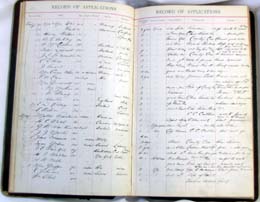This People's History is based on the early records of Wellspring Family Services, a private, non-profit organization helping families and children in Seattle and King County overcome life’s challenges. Founded in 1892 as the Bureau of Associated Charities, Wellspring Family Services has operated under a succession of names. This essay examines the organization in its earliest years through the lens of comments noted in the client record book. The organization's services have changed over the years, but have always centered on a commitment to a stronger, healthier community. These archival records offer glimpses into aspects of Seattle history not well documented elsewhere, examining attitudes toward poverty, need, illness, and addiction -- all of which have altered considerably since Wellspring's early days. This is one of a series entitled "Out of the Archives," and appeared in February 2011 in Wellspring's monthly internal newsletter, The Fiddlehead. It was written by Wellspring Family Services executive assistant Deborah Townsend.
Our First Client Records
The organization that eventually became Wellspring Family Services opened in February 1892 as the Bureau of Associated Charities of Seattle. It’s clear from the first client record book that the organizers were figuring things out as they went along.
Before they opened for business they had a ledger book printed up with columns for what we would call client data. Apparently they expected each case summary to take just one line across two pages, with one or two words in each space, everything very simple and straightforward. The "Remarks" column for other case notes is only 2.5 inches wide!
Some of the information they collected is familiar to any client intake process: Date, Name, Age, "Single or Married," "Nativity" (= place of origin), Occupation, Present Address. Some of the address entries are pretty sketchy: just "Ballard" for instance. Or "shack near Iron Works" or "opposite the power house on the Front Street cable line." Or, sadly, the one word "street."
The Bureau also asked "How Long in Seattle" (one applicant had been here just three days, one as long as 10 years) and "Church or Society" which seems to mean religious affiliation. Many of the earliest cases are marked "None" in this column, though we also see "Catholic," "Hebrew," "Luthern," and "Babtist." (The record-keeper had some spelling challenges.) There is one highly intriguing entry: "very loose," in quotation marks. We can only imagine what that meant!
Since the Bureau was organized as a clearinghouse and did not expect to give much direct aid itself, there was a "To Whom Sent" column for the actual referral. Many clients were sent on to the Board of Public Works, the County Farm, or the Clara Barton Society. We also see reference to the Ladies' Relief Society, the Ladies' Hebrew Society, Father Prefontaine, and names of various companies or individuals who could offer temporary employment. And we soon start getting hints of much longer stories, in entries like "Sent two children to asylum, woman able to take care of herself"; "Gave four jobs [of day labor] & sewing for his wife"; and "Refused to assist him to return to Sweden." Some of the entries are highly judgmental: "A constant annoyance to City and County"; "A miserable drunkard, help useless"; and even "This old lady is a cunning beggar, will not go to [County] Farm, she is getting food from restaurants” -- this last description in tiny handwriting squeezed into that 2.5 inch Remarks space. The note "Not an object of charity" appears repeatedly -- meaning, unfortunately, that that person was classified as one of the unworthy poor and didn’t deserve aid.
During February, March, and April 1892 the Agent (the Bureau’s one employee) tried to make the one-line-per-case format work for client summaries, but then it looks like he just gave up. There’s a three-month gap in the ledger book -- we’ll never know why -- and, in August 1892, the Agent and the volunteer "Friendly Visitors" began using the same book with only a few cases per page, making notes on every interaction with the client to allow for case histories sometimes lasting several months.

